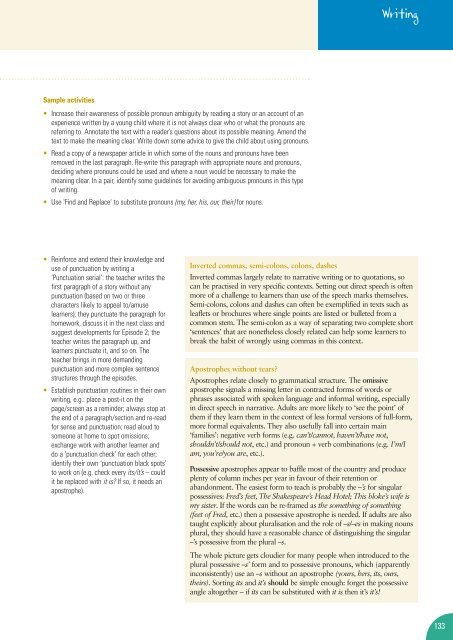Adult Literacy Core Curriculum - Nationally developed Skills for Life ...
Adult Literacy Core Curriculum - Nationally developed Skills for Life ...
Adult Literacy Core Curriculum - Nationally developed Skills for Life ...
You also want an ePaper? Increase the reach of your titles
YUMPU automatically turns print PDFs into web optimized ePapers that Google loves.
Sample activities<br />
• Increase their awareness of possible pronoun ambiguity by reading a story or an account of an<br />
experience written by a young child where it is not always clear who or what the pronouns are<br />
referring to. Annotate the text with a reader’s questions about its possible meaning. Amend the<br />
text to make the meaning clear. Write down some advice to give the child about using pronouns.<br />
• Read a copy of a newspaper article in which some of the nouns and pronouns have been<br />
removed in the last paragraph. Re-write this paragraph with appropriate nouns and pronouns,<br />
deciding where pronouns could be used and where a noun would be necessary to make the<br />
meaning clear. In a pair, identify some guidelines <strong>for</strong> avoiding ambiguous pronouns in this type<br />
of writing.<br />
• Use 'Find and Replace' to substitute pronouns (my, her, his, our, their) <strong>for</strong> nouns.<br />
• Rein<strong>for</strong>ce and extend their knowledge and<br />
use of punctuation by writing a<br />
‘Punctuation serial’: the teacher writes the<br />
first paragraph of a story without any<br />
punctuation (based on two or three<br />
characters likely to appeal to/amuse<br />
learners); they punctuate the paragraph <strong>for</strong><br />
homework, discuss it in the next class and<br />
suggest developments <strong>for</strong> Episode 2; the<br />
teacher writes the paragraph up, and<br />
learners punctuate it, and so on. The<br />
teacher brings in more demanding<br />
punctuation and more complex sentence<br />
structures through the episodes.<br />
• Establish punctuation routines in their own<br />
writing, e.g.: place a post-it on the<br />
page/screen as a reminder; always stop at<br />
the end of a paragraph/section and re-read<br />
<strong>for</strong> sense and punctuation; read aloud to<br />
someone at home to spot omissions;<br />
exchange work with another learner and<br />
do a ‘punctuation check’ <strong>for</strong> each other;<br />
identify their own ‘punctuation black spots’<br />
to work on (e.g. check every its/it’s – could<br />
it be replaced with it is? If so, it needs an<br />
apostrophe).<br />
Writing<br />
Inverted commas, semi-colons, colons, dashes<br />
Inverted commas largely relate to narrative writing or to quotations, so<br />
can be practised in very specific contexts. Setting out direct speech is often<br />
more of a challenge to learners than use of the speech marks themselves.<br />
Semi-colons, colons and dashes can often be exemplified in texts such as<br />
leaflets or brochures where single points are listed or bulleted from a<br />
common stem. The semi-colon as a way of separating two complete short<br />
‘sentences’ that are nonetheless closely related can help some learners to<br />
break the habit of wrongly using commas in this context.<br />
Apostrophes without tears?<br />
Apostrophes relate closely to grammatical structure. The omissive<br />
apostrophe signals a missing letter in contracted <strong>for</strong>ms of words or<br />
phrases associated with spoken language and in<strong>for</strong>mal writing, especially<br />
in direct speech in narrative. <strong>Adult</strong>s are more likely to ‘see the point’ of<br />
them if they learn them in the context of less <strong>for</strong>mal versions of full-<strong>for</strong>m,<br />
more <strong>for</strong>mal equivalents. They also usefully fall into certain main<br />
‘families’: negative verb <strong>for</strong>ms (e.g. can’t/cannot, haven’t/have not,<br />
shouldn’t/should not, etc.) and pronoun + verb combinations (e.g. I’m/I<br />
am, you’re/you are, etc.).<br />
Possessive apostrophes appear to baffle most of the country and produce<br />
plenty of column inches per year in favour of their retention or<br />
abandonment. The easiest <strong>for</strong>m to teach is probably the –’s <strong>for</strong> singular<br />
possessives: Fred’s feet, The Shakespeare’s Head Hotel; This bloke’s wife is<br />
my sister. If the words can be re-framed as the something of something<br />
(feet of Fred, etc.) then a possessive apostrophe is needed. If adults are also<br />
taught explicitly about pluralisation and the role of –s/–es in making nouns<br />
plural, they should have a reasonable chance of distinguishing the singular<br />
–’s possessive from the plural –s.<br />
The whole picture gets cloudier <strong>for</strong> many people when introduced to the<br />
plural possessive –s’ <strong>for</strong>m and to possessive pronouns, which (apparently<br />
inconsistently) use an –s without an apostrophe (yours, hers, its, ours,<br />
theirs). Sorting its and it’s should be simple enough: <strong>for</strong>get the possessive<br />
angle altogether – if its can be substituted with it is then it’s it’s!<br />
133

















